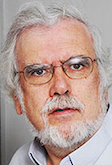


Prof. Geoffrey R. Mitchell
Professor Geoffrey Mitchell studied in Sheffield and London before obtaining a PhD working with Alan Windle at the University of Cambridge, UK. His PhD thesis focused on the study of the local structure of polymer melts and glasses using x-ray scattering and computational modelling. He spent a period in Cambridge as a research fellow with a programme centered on the study of liquid crystal polymers. This was followed by a spell at Hokkaido University, Japan with Professor Akira Odajima applying nmr and dielectric measurements to main-chain liquid crystal polymers. In 1984 he took up a lectureship in physics at the University of Reading, was appointed Reader in Polymer Physics in 1992 and Professor of Polymer Physics in 1995. He was the Founding Coordinator of the Polymer Science Centre a collaborative research programme in polymer science involving the Departments of Physics and Chemistry. In 2005 he was the founding Director of the Centre for Advanced Microscopy at Reading which was University wide centre of excellence. In 2013 he was appointed Emeritus Professor. In 2010 he joined the staff of the Centre for Rapid and Sustainable Product Development at the Institute Polytechnic of Leiria. Previously he had been Visiting Professor of IPL since 2004. He is now Vice-Director of CDRSP since 2014.
Professor Mitchell has a broad experience of materials research ranging from non-linear optics through smart materials to the microstructural study of technologically important materials. He has developed novel time-resovig techniques in x-ray and neutron scattering for the study of both local structure and the influence of external fields (shear and extensional flow, stress, magnetic, electric) on polymer melts, glasses, liquid crystal polymers and crystallisable polymers. He has combined such scattering techniques with computational modelling to reveal quantitative information about the segmental packing in polymer melts and glasses. He has pioneered the study of liquid crystal elastomers including both chiral networks and the use of such networks as smart materials. He was one of the first to develop photoactive materials for a variety of applications, including non-linear optics, optical fibre switches, coatings and smart systems. In the last 15 years he has developed strong interest in additive manufacturing, firstly with the development of a novel UV/IR Stereolithography process and then the influence of 3-d printing processes of the structure and morphology of the final products. He has developed a strong interest in electrospinning and was amongst the first to evaluate the effect of the electrospinning parameters on the polymer structure of the fibres. He initiated and has chaired a highly successful conference series on electrospinning. This has led to a book ‘Electrospinning: principles, practice and possibilities’ published by the Royal Society of Chemistry in 2015. He is just completing a further book to be published by Springer ‘Controlling the Morphology of Polymers: Multiple Scales of Structure and Processing’.